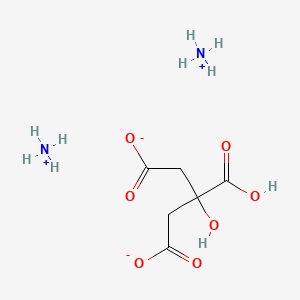



API Suppliers

US DMFs Filed
0

CEP/COS Certifications
0

JDMFs Filed
0
EU WC
0
Listed Suppliers
0
0

USA (Orange Book)
0

Europe
0

Canada
0

Australia
0

South Africa
0
Uploaded Dossiers
0
U.S. Medicaid
0
Annual Reports
0
0
USFDA Orange Book Patents
0
USFDA Exclusivities
0
Blog #PharmaFlow
0
News
0
EDQM
0
USP
0
JP
0
Other Listed Suppliers
0
0


1. Da-h-c Cpd
2. Diammonium Hydrogen Citrate
1. 3012-65-5
2. Microstop
3. Diammonium Hydrogen Citrate
4. Dibasic Ammonium Citrate
5. Ammonium Monohydrogen Citrate
6. Ammonium Citrate, Dibasic
7. Citric Acid Diammonium Salt
8. Ammonium Citrate Dibasic
9. Ammonium Hydrogen Citrate
10. Ammonium Monohydrogencitrate
11. Citrate (diammonium)
12. 2-hydroxy-1,2,3-propanetricarboxylic Acid, Diammonium Salt
13. Mfcd00013068
14. 1,2,3-propanetricarboxylic Acid, 2-hydroxy-, Diammonium Salt
15. Ammcitrate
16. Diammonium 3-carboxy-3-hydroxypentanedioate
17. Diammonium Hydrogen 2-hydroxypropane-1,2,3-tricarboxylate
18. Citric Acid Ammonium Salt
19. Ammonium Monohydrogen Citrate; Citrate Diammonium Hydrogen
20. Ammonium Monohydrogencitrat
21. N9bug430k8
22. Chebi:63076
23. Citric Acid, Diammonium Salt
24. Diammonium Citrate (secondary)
25. Hsdb 300
26. Einecs 221-146-3
27. Unii-n9bug430k8
28. Ai3-26173
29. Diammonium 2-hydroxy-1,2,3-propanetricarboxylate
30. Ammonium Citrate Dibasic Acs Granular
31. Diazanium;3-carboxy-3-hydroxypentanedioate
32. Db-047712
33. 1,2,3-propanetricarboxylic Acid, 2-hydroxy-, Ammonium Salt (1:2)
| Molecular Weight | 226.18 g/mol |
|---|---|
| Molecular Formula | C6H14N2O7 |
| Hydrogen Bond Donor Count | 4 |
| Hydrogen Bond Acceptor Count | 7 |
| Rotatable Bond Count | 3 |
| Exact Mass | 226.08010079 g/mol |
| Monoisotopic Mass | 226.08010079 g/mol |
| Topological Polar Surface Area | 140 Ų |
| Heavy Atom Count | 15 |
| Formal Charge | 0 |
| Complexity | 216 |
| Isotope Atom Count | 0 |
| Defined Atom Stereocenter Count | 0 |
| Undefined Atom Stereocenter Count | 0 |
| Defined Bond Stereocenter Count | 0 |
| Undefined Bond Stereocenter Count | 0 |
| Covalently Bonded Unit Count | 3 |
...The distribution of (15)N from ammonium citrate, administered by different routes, into the proteins of various tissues of hypophysectomized rats /was examined/. The liver, kidney, and spleen contained greater concentrations of (15)N incorporated into proteins than heart or muscle fractions during 72 hr following intragastric, intraperitoneal, and subcutaneous administration of 15N-ammonium citrate. After the first 6 hr, during which the intragastric route gave higher values, the quantity of (15)N incorporated into liver-protein was not substantially affected by the route of administration. In most of the other tissues studied, however, (15)N incorporation tended to be least by the intragastric route, followed, in increasing order, by the intraperitoneal and subcutaneous routes. By the last route, more labelled ammonia was apparently made available to the widely distributed glutamine-synthetase (EC 6.3.1.2) system. /Ammonium citrate/
WHO; Environ Health Criteria 54: Ammonia p.105 (1986)
Results of studies on the metabolic fate of dietary ammonium citrate and intravenously-administered ammonium lactate in rats showed that urea synthesis represented a nearly constant fraction of the administered ammonia over a large concentration range. Besides glutamine and urea, labelled nitrogen also appeared in creatine, glycine, alanine, proline, histidine, arginine, glutamic acid, and aspartic acid. ...The incorporation of (15)N from ammonium citrate into proteins of liver, heart, kidney, spleen, and muscle fractions of untreated and growth hormone-treated, hypophysectomized rats /was examined/, and found differences in the metabolic fate, depending on the route of administration. Subcutaneous injection facilitated the labelling of amide nitrogen, indicating extensive disposition via glutamine synthesis. In contrast, intragastric or intraperitoneal administration resulted in the labelling of arginine, glutamic acid, and other alpha-amino acids of the liver. Amide-nitrogen was labelled to a much lesser extent than by the subcutaneous route. The tissue distribution of the label also differed according to the route of entry. /Ammonium citrate/
WHO; Environ Health Criteria 54: Ammonia p.106 (1986)


